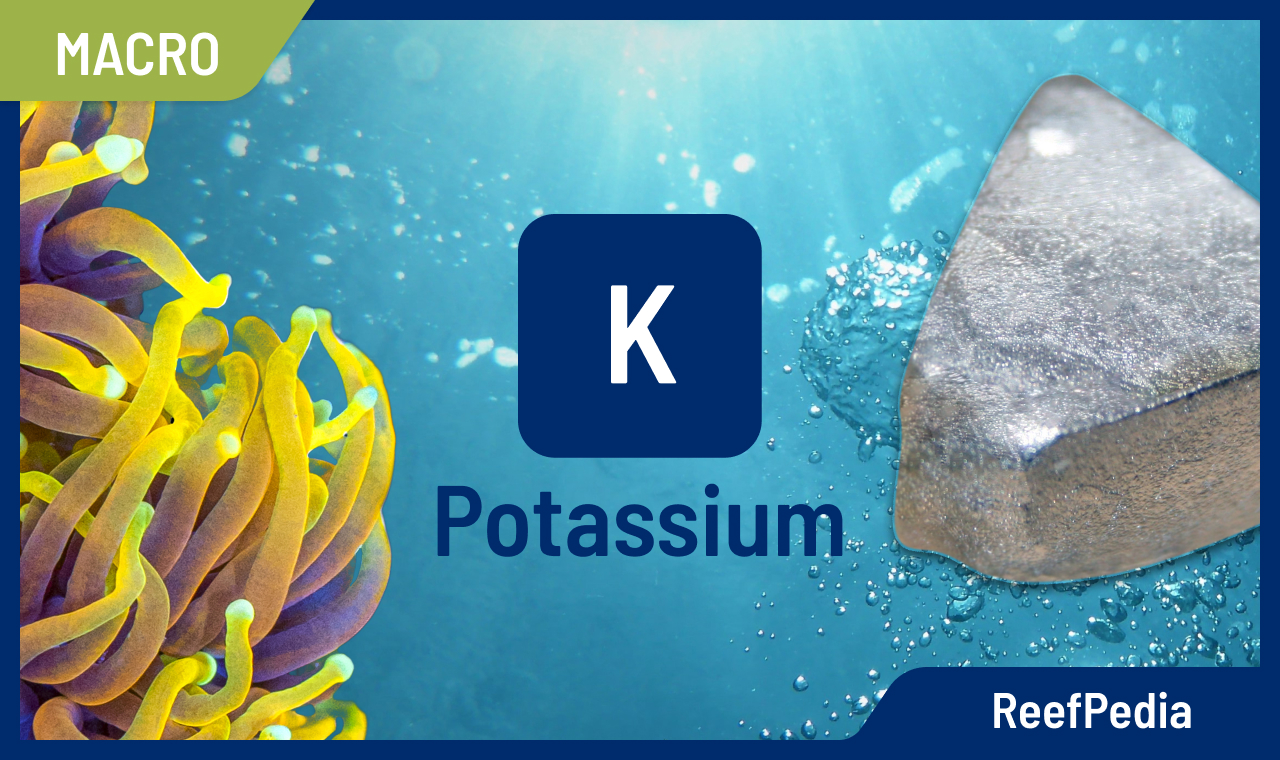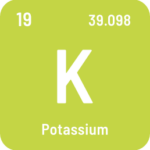 What is POTASSIUM (K)?
What is POTASSIUM (K)?
Potassium (K, Latin kalium) is a chemical element belonging to the first group of the periodic table, the so-called alkali metals*. Potassium is the lightest known metal with high chemical reactivity, therefore it does not occur in nature in a free state. Its content in the earth’s crust is 2.4%. It’s a component of minerals such as: sylvine, sylvinite, carnallite, kainite, langbeinite and various aluminosilicates.
Potassium forms chemical compounds in which it occurs primarily in the +I oxidation state, such as potassium iodide (KI), potassium permanganate (VII) (KMnO4) or potassium chloride (KCl).
Potassium occurs in seawater and belongs to the group of macroelements. Its correct content should be between 380-440 ppm.
The importance of potassium in seawater
Potassium belongs to the group of macroelements and is essential for the life of all organisms in a marine aquarium. Maintained at a constant level, it will be one of the key elements of success in running a tank. The content of potassium (K) is comparable to the amount of calcium (Ca) in seawater – both of these elements are equally important in saltwater aquaristics. The correct concentration of potassium, in relation to the other macronutrients, is significant for keeping a healthy reef. Note that the potassium content in the tank should always be 20 ppm (mg/L) lower than the calcium content.
In marine aquaristics, potassium is responsible for building and nutritional functions, it also takes part in metabolic processes. At the same time, it’s a nutrient for zooxanthellae (symbiotic coral algae) and it also affects coral coloration.
The roles of potassium
Building (growth of the coral skeleton)
Potassium is responsible for maintaining proper alkalinity inside the soft tissue of corals, and thus for functioning of the calcification process. The optimal concentration of potassium therefore affects the proper growth of coral skeletons.
The presence of potassium in aragonite (a crystalline form of calcium carbonate; CaCO3) is confirmed, although it’s not yet clear how it’s located in the aragonite crystal lattice. The size of ionic radius (the distance of the electrons furthest from the nucleus of the atom) of potassium differs from the ionic radius of calcium by 15%, hence it is not possible to exchange calcium for potassium.
Nutritional
It plays an important role in transporting nutrients in corals, it’s also substantial in the nutrition of zooxanthellae and biofilms. Potassium is responsible for the transport of some proteins and co-creates chromoproteins (complex proteins that give color under the influence of electromagnetic radiation).
Potassium is also important for the proper functioning of zooxanthellae – they use it in the process of photosynthesis, in which organic compounds, such as glucose, are produced.
Coloration of corals
The optimal level of potassium ensures nice coloration in corals. An example is Acropora valida, a coral that, with the correct potassium content in the water, will have a light tissue and a light purple color.
Problems related to excess and deficiency of potassium in seawater
Low potassium levels impair nutrient exchange and can lead to reduced coral growth rates. If its value in seawater is below 380 ppm, a deficiency can lead to detachment of coral tissues. The negative effects of a low potassium content are intensified when the level of phosphate (PO4) is also low.
On the other hand, too high a concentration of potassium disturbs the exchange of nutrients in aquarium animals and has a negative effect on the growth and coloration of corals. Generally speaking, high potassium values are not as dangerous for corals as its deficiency. However, we should keep in mind that animals, such as shrimp, are damaged already at 500 ppm of potassium, and a further increase in the content of this element leads to their death.
Both low and high concentrations of potassium in seawater disrupt the nutrient cycle, damaging the growth and coloration of corals.
How to protect the aquarium?
Potassium content should be checked regularly and maintained at the correct level. We recommend keeping potassium at 380 – 440 ppm, with the optimal value being 410 ppm. Such a level of potassium in seawater ensures health and beautiful coloration of animals. A decrease in the level of potassium, by even as little as 5%, slows down the growth of coral skeletons and their coloration.
The K parameter can be controlled in several ways:
Method I: systematic testing of potassium content in sea water, at home, using drop tests available on the market.
Method II: the most accurate and reliable method of determining potassium in sea water is the ICP-OES (Inductively Coupled Plasma Optical Emission Spectrometry) analysis.
Indicators of abnormal potassium (K) levels in a marine aquarium
- A certain group of corals reacts to changes in potassium levels, by observing the life in the tank you can react quickly. Examples are:
Seriatopora – with potassium deficiency: growth decrease, gray and pale color. Its tissue at the base dissolves - Montipora, e.g. red – with potassium deficiency: growth decrease
- Acropora – with potassium deficiency: loss of color, paleness, lack of growth and even death with constant potassium deficiency
- Turbinaria Reniformis – with potassium deficiency: growth decrease and withering.
Deficiency:
- partial tissue detachment
- paleness and gray in color
- decrease in skeletal growth
Escess:
- visible spots
- damage and, in extreme cases,
- death of shrimp
Recommendations
To ensure the proper level of potassium in the aquarium, you should regularly test it.
If the potassium level is above 440 ppm, we’re dealing with an overdose. The most common reasons for exceeding the recommended potassium level are too high doses of administered fluids (check the dosing parameters on the dosing pumps) and incorrectly prepared salt. Find and eliminate the cause of the problem and lower the value of this parameter in the water. Perform up to 6 water changes. It is recommended to replace approximately 15% of the aquarium water volume with each change, until the recommended value of this parameter is reached. Water prepared for replacement must be characterized by an appropriate level of target salinity. Use salt with the correct parameters and composition for the ICP test.
When the potassium is below 380 ppm, in order to compensate for its level, we recommend using products containing this element. To ensure a constant level of potassium in a marine aquarium, we recommend systematic supplementation of this element, depending on the coral stock in your aquarium.
*The name alkali metals refers to the elements in group I of the periodic table.
About author

Magdalena Metzler
Privately, I am a mother and a lover of nature and sport. My main interest is quantum chemistry, which hides a whole lot of unsolved mysteries and connections, which is extremely exciting from a scientific point of view.
In my scientific career, I have conducted international projects focused on innovative solutions for many branches of business, e.g. automotive, construction, and now, of course, marine aquaristics.
Working at Reef Factory gave me a passion for marine aquaristics, which I can develop every day, building a chemistry department and creating products that will help aquarists take care of tanks and ensure the highest safety of animals.
One of the most exciting memories of working at Reef Factory is the commissioning of the ICP-OES spectrometer, which analyzes the elemental composition of seawater. The method of analysis in ICP is based on an analytical technique, which is a combination of my passion for quantum chemistry and marine aquaristics.
I hope you find my articles on ReefPedia interesting and helpful! Happy reading :))
Magda


 What is POTASSIUM (K)?
What is POTASSIUM (K)?